Desired outcomes, aims, goals, intentions, objectives, plans, purposes and targets all describe a preferred future.1 When in the future and what kind of outcome makes a difference to how we facilitate clients to realise their desires. Whether a person wants to take a decision in the here and now, or to enjoy the rest of their life, involves different timeframes and structurally different outcomes. We suggest these desires need to be thought about and worked with in subtly different ways.
This paper examines modelling the timeframes, structures and evidence of client’s desires. But why?
To guide where and what to invite the client to attend to (in their inner landscape).
and
To offer the client the opportunity to consider potential:
-
- Gaps
- Inconsistencies, illogicalities
- Pitfalls, downsides
- Solutions becoming problems
- Broader & longer frames (ecology of larger system)
- Trade-offs
- Binds: paradoxes, impasses, conflicts, dilemmas
- Translations (a pattern that repeats in different guise)
- Constraints (physical, legal, ethical).
Timeframes
We’ve long sung the praises of using the before-during-after distinctions to model the sequence of an event.2 Yet timeframes are something else. They define the relative period of time when one event, or a series of events, happen. In terms of facilitating a person or a group to realise a desired outcome we have found that there is rarely a need to model timeframes too specifically, and that four general categories suffice:
In the moment
During the session
After the session
Over the long-term
For example:
| CLIENT DESIRED OUTCOME | EARLIEST TIMEFRAME |
| I’m now ready to make a decision. | In the moment |
| I want to know how to take the first step. | During the session |
| I would like to get married. | After the session |
| I want to have a happy life. | Over the long term |
In 2005 when we first diagrammed these timeframes on a training course we drew them as three nested squares and nicknamed it the 3-box model (see Figure 1).3
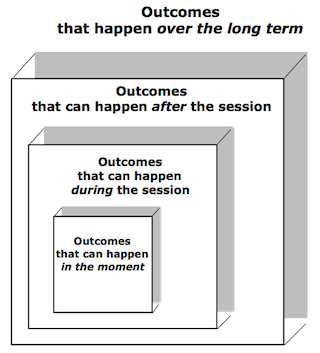
Figure 1: The 3-box model of outcome timeframes
Moments and duration
Modelling desired outcomes with the four timeframes listed above is only part of the story. We also take into account the temporal structure of the outcome.
To conceive of time, people punctuate the ongoing flow of life into moments and duration. Duration comes from the Latin meaning ‘to last’ implying a period of time. Whereas a moment is a brief duration that does not last. Durations are made up of many moments connected by a common context, and moments have to be relative to something, be that ‘now’, ‘the session’ or ‘my life’.
Moments can metaphorically move through time or create time depending whether time is perceived to exist independent of each moment, or not. For example, compare the notion of a timeline with a movie created frame by frame.
Some outcomes happen once and have a clearly delineated duration, others require specific events to happen many times. Other outcomes have a clear start and then continue for an unspecified duration. For others, it is not easy to identify a start and sometimes they continue indefinitely. Thus structurally, outcomes can be classified as:4
| One-off with an end (after which things are different) | e.g. Win the lottery. |
| Repeated (multiple times/events) | e.g. Give good presentations. |
| One-off and ongoing (outcome continues afterwards) | e.g. Get married. |
| Leading to ongoing (without a specific start or finish) | e.g. Be resilient. |
| Ongoing (continue with existing state) | e.g. Remain upbeat. |
| Ongoing until end | e.g. Enjoy this job until a better one comes along. |
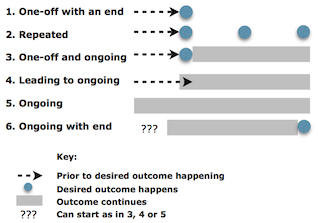
These six types of outcome are shown schematically in Figure 2.
Modelling
Timeframes and outcome structures are mostly presupposed and implied rather than explicitly specified. This requires us to notice subtle linguistic (verbal and nonverbal) cues that provide contextual and structural information.
For example, a client who says “My relationship has deteriorated. I need to improve my relationship and keep it on a better footing” implies a two-stage outcome – the first to happen soon after the session, and the second a long-term, ongoing outcome. Not only will the client need to get clear about the kind of improved relationship and what kind of better footing they would like, we assume that, given the relationship has deteriorated before, there is a possibility it could happen again in the future. Therefore we will also facilitate the client to recognise signs when the relationship has the potential to deteriorate again.
By contrast, the client who says “I want to be confident of my position before I go into the negotiations next week” could realise their outcome during the session, perhaps at a specific moment.
Although we have described archetypical frames and structures, we do not use them prescriptively when modelling our clients’ perceptions and facilitating them to self-model. We ask questions which invite clients to examine the appropriateness, coherence and compatibility of what they specify. We hold them to the inherent logic of their own standards and criteria.5
We use our knowledge of generic or representative outcomes as a template to guide the modelling. This means rather than imposing our perceptions on the client, we can compare and contrast the client’s perceptions to our extensive store of experiential knowledge.
Using generic schema as comparative templates results in either an approximate correspondence or an incompatibility. A lack of correspondence is a sure sign that more modelling is required. And, if the client and facilitator are from different cultures extra sensitivity is required.
Idiosyncratic timeframes and outcome types
Many combinations of the ‘generic’ timeframes and outcome structures described above are possible and these will cover the majority of the ways people perceive their desired outcomes. However, you will encounter individual variations, and the idiosyncrasies are usually highly significant.
For instance, our schema of a generic marriage includes a specific start and a duration that continues until divorce or death, whichever comes first. However, we once worked with a client whose religious belief specified that marriage was not just for life, but “for all eternity”. Not only could we appreciate his bewilderment when his wife left him, we recognised the need to be extra vigilant to remain clean and work entirely within his structures.
Evidence
Often people are content to look for a way to remedy their problem without thinking beyond the solution. Rarely do they spend much time teasing out the likely implications and effects of their proposed solution or considering what they want after they have remedied the problem. This becomes clear when clients are asked what will let them know they have realised their desire. In other words, what are they using as evidence that they have experienced (some degree of) success.6
Before a client arrives for the first session with us, we not only ask them to consider what they would like to have happen, we also ask them: And how will you know this has happened?
If a person does not give a desired outcome in answer to the first question, they usually give one in their answer to the second. When we meet (in person or via the Internet) we not only explore their answers to these two questions, we also consider the relationship between the answers.
For example, people who have developed a dependency on alcohol frequently underestimate how long they need to stay sober before they establish a stable, healthy relationship with alcohol (which may or may not involve drinking again). They may think a few months or a couple of years of sobriety is sufficient, whereas our experience suggests a more appropriate timeframe is anywhere between ten years and never.
A different situation is the athlete who wants “to be someone” and will know he or she has achieved it when they have the gold medal around their neck. Presumably the outcome is ongoing while the evidence may only happen once, if at all. This apparent incompatibility may well become problematic after the athlete achieves their goal, or if they never do.
We suggest there is value in the evidence for knowing when an outcome will be realised being consistent with the outcome structure and the timeframe within which the outcome can occur.7
There may well be different kinds of evidence depending on whether it relates to: progress towards the outcome, the outcome happening, the outcome continuing or the outcome ending (see Figure 3).
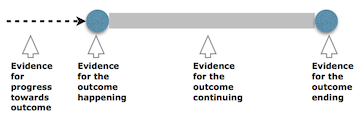
Figure 3: Types of evidence
While the Agile idea of ‘minimum viable product’ (MVP) is an important frame, we also use an MVP frame to stand for the evidence of ‘minimum viable progress’ (i.e. what’s the first step?).
To be clear, we do not see our job as therapists or coaches to specify ‘suitable’ evidence for our clients; however, we do think our role includes facilitating them to discover the implications of what they perceive as evidence. Having some idea of generic timeframes and outcome structures helps us to do that.
Facilitating change
Most often the timeframe of a client’s first answer to “And what would you like to have happen?” is sometime after the session, i.e. either in the outer most box or outside the three boxes altogether. During a Symbolic Modelling session the timeframe of the client’s desired outcome tends to move from the outside towards the centre of the three boxes until at some point the direction reverses. This occurs when:
The client starts to explore the effects of their desired outcome.
or
A change occurs which the facilitator seeks to mature the change.8
The arrows in Figure 4 show how the timeframes of the client’s desired outcomes commonly change during a session.
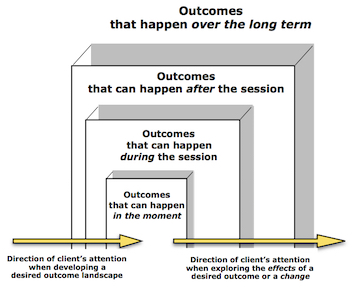
Figure 4: Typical changes in client desired outcome timeframes
Outcome timeframes are one way to track changes in a client’s attention. We usually encourage the movement towards what they would like to have happen during the session, often ‘going live’ by working directly with what is happening in-the-moment.
Once the client experiences a change, the maturing process is designed to facilitate the consolidation of changes and their evolution further and further into the symbolic future. It can also facilitate the client to examine the expected effects of the change on ‘real life’ contexts, especially those that have proved problematic for the client in the past and have the potential to do so again in the future.
Temporal prepositions and adverbs9
The developing questions of Clean Language hold time still; whereas the inclusion of temporal prepositions and adverbs invite the client to attend to different timeframes. The ones appearing most often in David Grove’s classic questions were:
(just) Before
Then
Next
Others we have found useful — conditional on the organisation of the client’s desired outcomes — are:
Now
After
Until
While
During
Beyond
Between
Throughout
In (this session)
Schematically, these can be represented as in diagram 5:
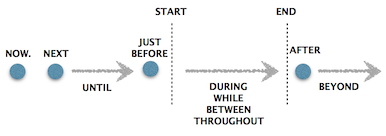
Figure 5: Schematic of temporal prepositions and adverbs
And what would you like to have happen …
… during this session?
… today?
… in the next X minutes / hours / days / … / years
… now?
… next?
… before [desired outcome]?
… until [desired outcome]?
… after [desired outcome]?
… beyond [desired outcome]?
… while [constraint on desired outcome]?
And what happens …
… just before [desired outcome]?
… after [desired outcome]?
And what needs to happen …
… for [desired outcome]?
… for [condition]?
… until [desired outcome]?
Levels and fractals
As experienced symbolic modellers we aim to work at two or more levels of organisation simultaneously. These levels roughly correspond to the timeframes of the 3-box model:
| TIMEFRAME | LEVEL OF ORGANISATION |
|---|---|
| On-going | Life pattern |
| After | Pattern of perceptions and behaviours |
| During | Relationship between perceptions and behaviours |
| Now | In-the-moment experience |
We consider what happens in the session to be a fractal of longer-term patterns that occur outside the session. Our motto is: It’s happening now. [Link available soon] Unless there is good reason not to do so, our three-fold aim is, simultaneously, to support the client’s system to:
- Learn from experiencing their in-session desired outcome
- Learn how to realise (and learn from) their after-the-session desired outcome
- Discover more ways of responding to the class of experiences represented by what happens in the session.
Working with the desire
As well as working with the outcome part of a desired outcome, it is sometimes important to put attention on the desire. Linguistically, structurally and in its simplest form, a desire is the relationship (link) between a person and the perceived outcome, i.e “I desire X”. By asking clean questions of the desire word in the outcome statement, we invite the client to attend to their want, would like, need, wish, hope for, etc. This can prove a useful option, especially when a person has difficulty formulating a desired outcome.
In one extreme example a client was unable to complete any sentence that started “I want …”. Every time she started to speak these words they “got stuck” in her throat. When a client has a difficulty stating a desired outcome they are often experiencing some kind a binding pattern. People who as children have internalised a parent’s injunction such as, “Those who want don’t get” find ways to get their desires met without directly asking for them. When we ask them ‘And what would you like to have happen?’, we are inadvertently triggering the binding pattern. While that can be difficult for the client, it certainly makes the problem clear for all to see.
Although outcomes that are desired are set in the future, the desire is in the present. The classic formulation of a desired outcome is “I want X”. Syntactically and emotionally the desire is closer to the “I” than is the outcome. Clients usually find it easier to answer questions about the words in a sentence which are furthest from the “I”. Until we have some experience of how a client responds we tend to start by asking questions about the right-hand side of the sentence and work our way towards words on the left-hand side.
Other applications
In this paper we have concentrated on desired outcomes, however other aspects of experience can usefully be substituted. For example, the timeframes and structure distinctions can equally be applied to any of the other categories in our REPROCess model: Resources, Explanation, Problems, Remedies, Changes.
Similarly, the distinctions are applicable to facilitating clients to self-model the conditions necessary for an outcome to occur. For instance, in our Clean Framework for Change coaching process, rather than a client figuring out how to go from where they are to their goal — from A to B — the process charts a path from B to A. Looked at though a timeframe lens this is the same outside-to-centre direction identified above.
Concluding remarks
Being able to minutely model idiosyncratic timeframes and outcome structures is a vital skill for a symbolic modeller. However, in therapy, coaching and other personal development contexts, a high degree of specificity is often not required. Most of the time the simple models described in this paper have sufficient complexity to effectively and efficiently guide the facilitation of clients to make the changes necessary to realise their preferred futures.
To help you develop these modelling skills we have designed three activities which can be downloaded here:
NOTES
1. We have a precise criteria for recognising a desired outcome statement, see our article on the Problem-Remedy-Outcome (PRO) model.
2. See Metaphors in Mind pages 72-77.
3. Vectors are the link between an in-the-moment facilitator process outcome and the client’s in-the-session desired outcome. See: Vectoring and Systemic Outcome Orientation.
4. The Fogg Model of Behavior Change has similar distinction using the metaphors: Dot (One time), Span (Period of time), Path (From now on). Fogg-Model-of-Behavior-Change.
We also note that the notion of ‘a start’ and ‘an end’ is a human construct and can have a remarkably wide range of meanings, even for the same ‘event’. See: Endings-and-Beginnings.
5. There are exceptions to this rule when we may introduce external standards, such as the Law and the safety of others in our work with sexual offenders.
6. This is a more general version of the “Test” criteria of the TOTE model devised by Miller, Galanter and Pribram in 1960 and often used in NLP.
7. This is an extension of Gregory Bateson’s idea of ‘code congruence’ — when the means of achieving something are compatible with the purpose for achieving it. Bateson suggests that code-incongruence can produce adverse double-binds, see: What-are-Double-Binds.
8. For a description exploring the effects and maturing changes see: Symbolic Modelling Lite: Emergent-Change-though-Metaphor-and-Clean-Language.
9. Seth Lindstromberg’s English Prepositions Explained (1998) is highly recommended. See also the notes of the previous Developing Group, Questioning Clean Language Questions: Exploring combinations and variations.








